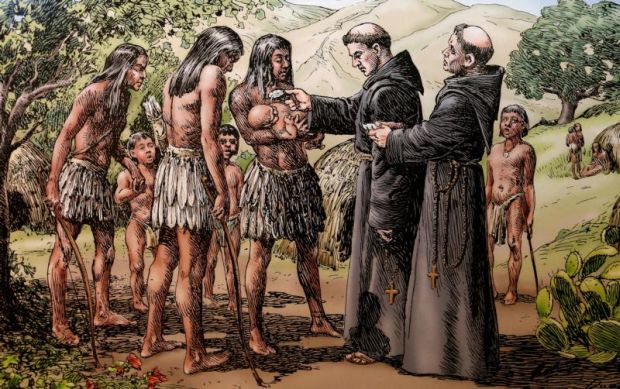SACRAMENTO, Calif. (CS) — Here is a timeline of key points in the life, ministry and sainthood cause of Blessed Juniper Serra, the 18th-century Spanish missionary to California. Pope Francis is scheduled to canonize the Franciscan friar Sept. 23 during his visit to Washington.
— 1713: Born and baptized Miquel Joseph Nov. 24 in Petra on Mallorca Island in the Mediterranean Sea. His humble family lives near the Franciscan Convento de San Bernardino, where the Serras attend Mass and the young Miquel begins his studies.
— 1730: Arrives in Palma, enrolls at notable Franciscan school, becomes a novice at 16.
[hotblock]
— 1731: Joins the Franciscans, taking the name Junipero, after a companion of St. Francis of Assisi admired by young Serra as the “greatest exemplar of holy simplicity.”
— 1737: Finishes studies with high honors. Likely ordained a priest this year.
— 1740: Appointed professor of theology at the Convento de San Francisco in Palma.
— 1744: At age 33, assumes the Duns Scots chair of philosophy at Lulling University, Palma.
— 1749: Receives call to report for missionary duty in the New World. Arrives in Veracruz, Mexico, Dec. 6. He and another Franciscan walk to Mexico City, a 240-mile journey. On the way, he develops a leg sore, possibly from an insect bite. The ulcer afflicts him for the rest of his life.
— 1750: Is appointed to the Sierra Gorda missions. Works there for nearly eight years. Oversees the construction of new churches.
— 1752: Becomes commissioner for the office of the Inquisition, with authority to investigate witchcraft, sorcery and heresy.
— 1758: Assigned to San Saba in region now known as Texas, but his transfer is retracted and he heads back to Mexico City. Works at the College of San Fernando teaching novices and travels the countryside preaching and holding popular missions. (The appointment to San Saba mission was considered too dangerous by his superiors. Two Franciscans were killed in a Comanche raid that destroyed the mission in March.)
— 1767: Appointed administrator of Baja (Lower) California missions.
— 1768: Is instructed to leave Baja and move north to establish missions in Alta (Upper) California.
— 1769: Arrives in San Diego, erects the first in a string of missions that would stretch north to Sonoma.
— 1770: Establishes Mission San Carlos Borromeo in Carmel, the headquarters for Franciscan efforts in California. He is credited with baptizing at least 530 Indians there.
— 1773: Journeys to Mexico City and successfully appeals to the Spanish viceroy for more autonomy in California mission affairs, hoping to curtail problems he had with Spanish forces about mission development and operations and treatment of the Indians.
— 1778: Secures permission to administer sacrament of confirmation among mission Indians. Confirms 1,716 people at five southern missions.
— 1782: Mission San Buenaventura is established 70 miles north of present-day Los Angeles. It’s the ninth and last Alta California mission founded under Serra’s leadership.
— 1784: Dies Aug. 28 at age 70 at San Carlos in Carmel.
— 1937: Vatican opens his cause for sainthood.
— 1988: St. John Paul II presides at his beatification ceremony Sept. 25 in St. Peter’s Square.
— 2015: In January, Pope Francis announces he will canonize Blessed Serra.
In his desire for missionary work, Blessed Serra was influenced by missionaries who came to the New World before him:
— St. Francis Solano, a Spanish Franciscan missionary to South America who was canonized in 1726, when Serra was 13. Credited with converting thousands of Indians.
— Father Antonio Llinas, a missionary to the Sierra Gordian region and founder of the apostolic College of Santa Cruz in Queretaro, Mexico. The institution trained scores of Franciscan missionaries.
— Father Antonio Margil de Jesus, a Spanish Franciscan and missionary to Sierra Gorda and one of the first missionaries to Texas. He walked barefoot and inflicted upon himself brutal punishment and mortifications “to protect his own innocence and to approach the purity of Christ’s selfless devotion.”
— Sister Maria de Jesus de Agreda, whose visions and reported information in New Mexico led Blessed Serra to believe that Indians would convert to Catholicism upon their first sight of Franciscans.
***
Sources: New Catholic Encyclopedia; “Juniper Serra: California’s Founding Father,” by Steven W. Hackle; “Guide to Serrano,” Santa Barbara Mission Archive-Library.
PREVIOUS: Cardinal Dolan denounces Trump’s anti-immigrant rhetoric
NEXT: Box believed to be Catholic artifact found at site of Jamestown church




Share this story